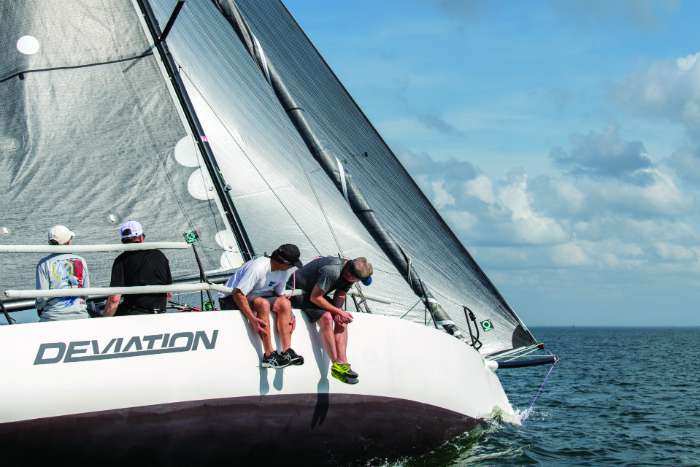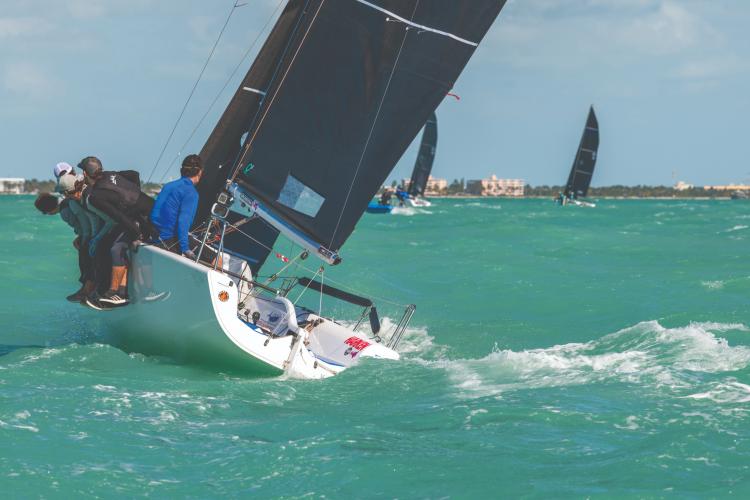The Beginnings of a Basic Sailboat Racing Glossary
We make our sport harder to understand than it should be. The combination of actual technical terms and slang can be an imposing barrier to those trying to get into sailboat racing. All too often I forget and start casually slinging around terms that make my editors go “huh?” So, we thought we would start Racer’s Edge 2024 off with a primer on frequently used terms from the race course. SpinSheet staff and readers have come up with their favorites. Here, written in totally random order (and alphabetized by my friendly editor) are the beginnings of a basic glossary.

Banging the Corner
If you immediately head all the way out to the lay line right from the start of the leg, you are “banging the corner.” Remember, once you are on the lay line, you are out of options. You can’t tack or gybe without sailing extra distance and you can no longer take advantage of any shift in the wind direction. Generally speaking, classical tactical maxims dictate staying out of the corners (away from the lay lines) until late in the leg (see lay line).
Consolidate
This refers to the age-old tactical missive “cross them when you can.” If you are looking good and are ahead of a bunch of your competition, go ahead and tack or gybe and physically cross and position yourself in front of them. “Consolidation” like this will also take you back towards the middle of the course and away from those nasty lay lines.
Duck
Ducking refers to the act of passing behind, instead of trying to go in front of a right of way (starboard tack) boat. Upwind this means bearing off to go behind. Downwind this means heading up. In either case it is important to remember that ducking is not a bad thing. It simply means you are even and want to continue going in the direction you are headed. When you tack or gybe and come back together, you will have the right of way. Usually it pays to have “last starboard.” That’s the one that will determine who gets to be ahead or behind at the mark.
Headers and Lifts
Righties and Lefties are also either a “header” or a “lift” depending on what tack we are on. A lift takes us more directly towards our upwind goal, a header farther away. Downwind this is reversed. Headers take us closer to our downward goal and lifts take us farther away. Let’s say we are back sailing upwind on port tack at our 90-degree compass heading. We get a lefty, and we are “lifted” to the point where we can sail an 80-degree heading. A righty comes through, and we can sail no higher than a 100-degree heading. We are headed. The simple rule to keep this all straight is “port higher header.” If the compass numbers that we can sail hard on the wind are getting bigger, we are headed. Smaller, and we are lifted. Of course, this is reversed on starboard tack where upwind higher numbers are good (lifts) and smaller numbers are bad (headers). And don’t forget that downwind we want headers!
Late Main Gybe
A technique for gybing a boat using an asymmetrical spinnaker where the main is held on the wrong (old leeward) side while the spinnaker is brought around to the new side first. This allows the spinnaker to fill because there is no mainsail in the way creating a wind shadow. As soon as the spinnaker fills, the mainsail is released and allowed to come over to new side. This works only in light to moderate conditions when the main boom can be held. In windier conditions you want to do a “priority main gybe,” where the mainsail comes across normally just as the boat passes dead downwind. If it is windy, you just want to get the mainsail across under control and not have it influence steering the boat.

Lay Line
If you are sailing windward/leeward races which go straight upwind and then straight downwind, the most common format in sailboat racing, lay lines are your boundaries. Upwind, it is the close-hauled course that allows you to make (“fetch”) the upwind mark. There is a starboard-tack and a port-tack lay line. Sailing farther to the right or left of these imaginary lines means you are sailing extra distance. Since in modern boats we also tack (gybe actually) downwind, there are also port and starboard lay lines. “Short” the lay line and you will have to sail too deep and slow to get to the mark. This is slow and painful. Go too far before gybing and you will find yourself sailing much higher than you need to or would like. Fast but extra distance. Ideally, upwind or down, the lay line allows you to sail the perfect optimal VMG course to the mark.
Lee Bow
A move which occurs when sailing upwind when one boat tacks just ahead and to leeward of another boat sailing upwind. If executed properly and the boats are close enough, the bad air coming off the boat ahead and to leeward will force the weather boat to tack because they can no longer sail optimum VMG upwind. Of course, you must get it right. Tack too close and the weather boat feels as if they have to alter course to avoid you, making it a foul. Not far enough forward after the tack is complete and there will be no room to build speed, and the weather boat may just sail right over (“roll”) you. The rule of thumb for a proper lee bow is that you need to be able to easily cross the other upwind boat in order to pull it off. A lee bow tack is used when you want to force the other boat to go the other way. A classic tactic when on or near a lay line.
Pressure
We used to simply call it wind velocity. But pressure is so much sexier. I think, as with so many of our other terms, it may have had its origins among our Kiwi brethren. More pressure means more wind, and yes, it does pressure (load up) sails. It is visible on the water. Darker streaks usually mean more pressure. It is the central focus of much onboard dialogue. “Pressure looks better on the right side of the course.” Or moment to moment as we try to squeeze the most out of the boat and help the trimmers anticipate. “More pressure in 10… 3, 2, 1; it is on us now.” Calling out increases or decreases is often a full-time job of one crew member. There are lots of associated phrases like “puff on” to indicate a big increase in wind velocity.
Righties and Lefties
We not only obsess about how much wind there is but also its constantly changing direction. Wind direction is monitored constantly via compass headings, fancy electronics that actually calculate where on the compass the wind is coming from, or from simple observation of what is happening to the headings of other boats which give clues to the changes in direction on the course in front of us. Much time is spent before a race to determine compass headings upwind on port and starboard tack. Median headings become the baseline. If we are on port sailing along at a heading of 90, but a shift in the wind makes it impossible and the best we can do is sail 100 degrees, that is a right shift or a “righty.” Conversely if we can now sail a compass heading that is less than 90 degrees, that is a left shift or a “lefty.”
Sambuca
There is lots of great slang when it comes to maneuvers. A “sambuca” is a gybe set where the spinnaker is hoisted as the boat is gybed around the weather mark. On boats using asymmetrical spinnakers (the vast majority these days) the sail is set up and launched on the port side. This means it has to get pulled all the way around to the starboard side of the boat during the hoist, while the boat is gybing. This takes some practice! But if you want to get immediately onto port tack, it is a trick you have to have in your bag.
VMG
Velocity made good either straight upwind or downwind. This has nothing to do with velocity made good used in navigation towards a waypoint or mark. Our VMG is all relative to getting upwind or downwind as fast as possible. It is usually measured as a percentage of our forward boat speed. Upwind if we try to sail too close to the wind (often referred to as “pinching”), we are aiming more upwind but losing speed as a result. If we sail at too wide an angle (“footing”), we will be fast but not going upwind very effectively. As always in making a sailboat go, it is striking the right balance between pinching and footing for a given condition that generates the best VMG and our best overall upwind performance. Downwind trying to sail too directly towards your objective will leave you low and slow. Too high an angle and you will be fast but not making great progress downwind. Once again, the game of optimizing VMG is about finding the balance.
We have lots of others. Clearly there is a reason why our sport is difficult to learn! Keep those cards and letters coming, and we will continue to help shed some light on the peculiar lingo of sailboat racing.
By David Flynn of Quantum Sails
Have more terms you’d like to have defined? Email [email protected].
**This article appears in our March 2024 issue, due out Feb. 27. ... Find more Racer's Edge columns here.




